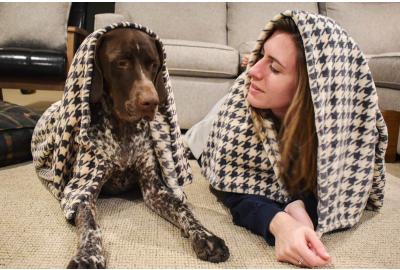Dogs with separation anxiety become anxious or fearful when their owner isn’t around.
This can negatively impact quality of life. Panic behavior can even lead to physical injuries.
Symptoms can be mild, moderate, or severe, and may include…
- Whining, howling, or barking.
- Panting.
- Restlessness.
- Trembling.
- House soiling.
- Destructive behavior (scratching, chewing, digging, or knocking objects over).
- Attempts to escape the home (so be sure all doors and windows are secure).
Since you’re away, you probably won’t observe these things firsthand—other than some whining or overexcitement when you’re leaving.
But, you may notice “clues” (house soiling, damage, neighbors complaining) after you return.

What Causes Separation Anxiety?
There are many possible factors, such as your dog’s history, genetics, personality type, learned behaviors, and more.
Big life changes, such as moving to a new home, can also spark anxiety.
Fortunately, regardless of cause, there are solutions to help your furry best friend.
- Desensitization is Crucial
- Start by picking up and jingling your keys. Repeat this several times, until your dog doesn’t react to the sound (this may take a few days).
- Then, open the door and step outside, but come right back inside. Repeat this until your dog shows no reaction.
- Then, go outside for 2 minutes… 5 minutes… 10 minutes… an hour… and so on.
- Should your dog ever react with anxiety, go back to the previous step and start again.
- If possible, have a pet sitter or friend stay with your pup (or use doggy daycare) while you’re at work. Desensitization works best if you can avoid a triggering event (i.e., you being gone all day) during the process.
- A “Safe Space” Provides Security
- Your Veterinarian Can Help
This process has two components…
Make your comings and goings less exciting/triggering.
Remain quiet and composed when you enter or leave the home. And, wait until your dog is calm to interact.
Dogs pick up on our emotional cues, so if you’re calm, they may follow your lead.
Gradually get your dog used to you leaving the home.
Desensitization is effective, but can take weeks to months—it’s a marathon, not a sprint.

A space that’s all their own can provide your dog with additional comfort and security.
This could mean a crate, bed, or favorite blanket—or, all of the above. While crates may look a little “prison-like” to us humans, remember that dogs are den animals. Den-like spaces help them feel safe.
A crate outfitted with a nice, soft bed or blanket can be that perfect den your dog is looking for—a cozy place to cuddle up until you return.
To help your dog warm up to their crate or bed, offer praise, attention, or a special treat whenever they rest calmly in it.
First, your vet will rule out underlying medical conditions as a cause of the symptoms.
For example, house soiling may be due to a urinary tract infection rather than separation anxiety.
If it is anxiety, your vet may offer…
- Additional advice on what to do at home—and possibly referral to a behaviorist.
- Natural calming aids like supplements or pheromone products.
- Prescription medications for stress (often used short-term during the desensitization process).
How to Support Your Dog
Your dog doesn’t want to feel anxious—they just can’t help it.
Patience, consistency, and compassion are key to supporting your dog’s mental and emotional health as they develop the confidence to stay home alone.
Once anxiety is managed, you can worry less, and truly enjoy every special moment with your furry best friend.
Additional Reading:
https://www.aspca.org/pet-care/dog-care/common-dog-behavior-issues/separation-anxiety
https://www.mspca.org/pet_resources/dealing-with-separation-anxiety-in-dogs






